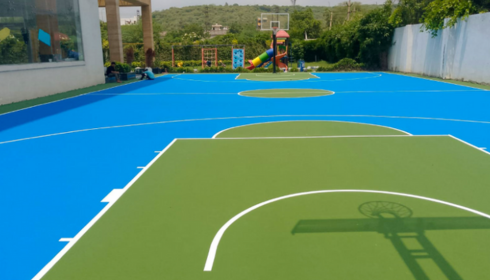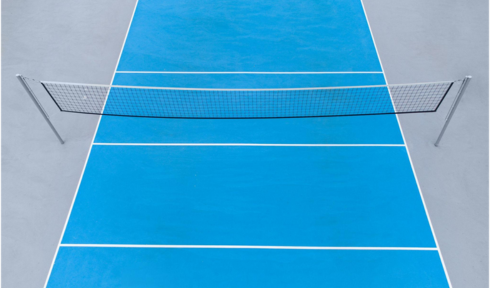Basketball is more than a sport—it’s a high-impact, fast-paced game that demands precision, traction, and durability from the surface it’s played on. The foundation of every great game lies in high-quality basketball court flooring designed to deliver the right bounce, grip, and resilience.
Whether it’s an academy court, a school facility, or a community project, investing in the right basketball court material and hiring experienced basketball court builders ensures professional-grade performance and long-lasting results.
Importance of Choosing the Right Basketball Court Flooring
The basketball court flooring directly influences player safety, performance, and maintenance requirements. A surface that’s too slippery can lead to injuries, while a surface that’s too hard may cause fatigue and joint stress.
Modern flooring systems—especially synthetic acrylic surfaces—offer a perfect balance between comfort, consistency, and cost-efficiency. These systems are ideal for India’s climate, where heat, humidity, and rain demand UV-stable, water-resistant, and low-maintenance solutions.
Benefits of synthetic basketball court flooring include:
- Superior Grip: The silica-sand texture ensures controlled traction.
- UV Resistance: High-grade pigments retain color vibrancy under harsh sunlight.
- Weather Durability: Prevents cracks, peeling, or water damage.
- Low Maintenance: Requires minimal cleaning and resurfacing.
- Custom Appearance: Available in multiple colors to match club or school branding.
Basketball Court Builders: Why Expertise Matters
Constructing a professional court is not just about pouring concrete and painting lines. It’s an engineered process requiring experience, precision, and material expertise. Reputed basketball court builders follow global standards—from base preparation to acrylic coating—to ensure top-notch results.
What professional builders ensure:
- Correct slope (1:100) for efficient drainage.
- Durable asphalt or concrete base for structural stability.
- Accurate layer thickness to maintain bounce consistency.
- ITF and ASTM-certified materials for international-grade play.
- Precision line marking as per FIBA and NBA guidelines.
Choosing an experienced construction partner guarantees a surface that performs well year-round, even under heavy usage.
Understanding Basketball Court Material Options
The choice of basketball court material determines how the court performs, feels, and ages. While traditional wooden courts remain popular for indoor arenas, outdoor facilities rely heavily on synthetic systems for cost-effective durability.
Most Common Basketball Court Materials:
- Acrylic Flooring: A multi-layer system applied over asphalt or concrete. It offers perfect ball bounce, smooth texture, and vibrant colors—ideal for outdoor setups.
- PU (Polyurethane) Flooring: Provides elasticity and cushioning but is more expensive and better suited for indoor use.
- PP Tiles (Polypropylene): Modular tiles that are easy to install but may fade or warp under prolonged sunlight.
Among these, acrylic flooring is the preferred choice in India due to its balance of performance, cost, and climate adaptability.
Outdoor Basketball Court Floor Material
When it comes to open-air setups, the outdoor basketball court floor material must withstand fluctuating temperatures, rain, and UV radiation without losing texture or color.
Ideal properties for outdoor basketball flooring:
- Non-Slip Finish: Ensures safe play even in light moisture.
- Heat Reflective Coating: Reduces surface temperature for comfortable play.
- UV-Stable Pigments: Protect against color fading.
- Water-Based Composition: Eco-friendly and resistant to delamination.
High-quality acrylic coatings excel in all these areas, providing a smooth, resilient surface that performs consistently across seasons.
The Role of a Trusted Basketball Court Manufacturer
A reliable basketball court manufacturer provides more than just materials—they bring technical expertise, certified products, and installation guidance. Top manufacturers design their acrylic systems specifically for sports performance, ensuring excellent adhesion, flexibility, and endurance.
What to look for in a basketball court manufacturer:
- ISO and ITF-certified product quality.
- UV-resistant pigments and anti-fade formulations.
- Availability of cushioned and non-cushioned systems.
- Technical support for layering and application.
- Proven project portfolio across institutions and clubs.
Partnering with an experienced manufacturer ensures your court performs like a professional arena—whether it’s built for schools, societies, or national-level academies.
How Basketball Floor Material Affects Performance
The basketball floor material has a direct impact on player movement, ball rebound, and surface comfort. A well-designed acrylic floor creates a balance between friction and smoothness, offering ideal traction without abrasiveness.
Performance aspects influenced by the flooring system:
- Bounce Consistency: Uniform layer thickness provides predictable rebound.
- Shock Absorption: Cushioned systems reduce stress on ankles and knees.
- Aesthetic Appeal: Multi-color options enhance visibility and court design.
- Longevity: High-quality coatings last 5–7 years before resurfacing.
In competitive or training environments, consistent flooring quality helps players develop their skills with better confidence and precision.
Steps in Basketball Court Construction
A successful basketball court flooring project involves several technical steps, all of which must be executed with accuracy:
- Site Preparation: Evaluate slope, soil strength, and drainage.
- Base Construction: Use asphalt or concrete for a stable foundation.
- Surface Priming: Apply primer to improve coating adhesion.
- Resurfacing & Cushion Layers: Level out imperfections and add comfort.
- Color Coating: Apply multiple layers of pigmented acrylic coating.
- Line Marking: Add accurate FIBA-standard court lines.
- Final Curing: Allow the court to set properly before play.
This systematic process ensures a durable, aesthetically appealing, and high-performance basketball surface that meets global play standards.
Maintenance and Longevity Tips
Even the best flooring needs care to maintain its performance and aesthetics.
Maintenance best practices:
- Clean the surface regularly to prevent dust and debris accumulation.
- Inspect annually for cracks or surface wear.
- Avoid heavy equipment or vehicles on the court.
- Recoat every 5–6 years depending on usage intensity.
Routine maintenance not only preserves appearance but also enhances safety and playability.
Why Acrylic Systems Lead the Market
Among all materials available, acrylic basketball court flooring offers the perfect combination of performance, durability, and cost-effectiveness. It’s eco-friendly, customizable, and engineered for all-weather reliability—making it the go-to choice for schools, clubs, and housing societies.
Its seamless surface ensures uniform bounce, and its UV-stable formula guarantees that your court retains its professional look and function for years, even under extreme sunlight or rainfall.
Conclusion
A well-constructed basketball court begins with the right basketball court flooring and the expertise of professional basketball court builders. From selecting durable basketball court material to working with a trusted basketball court manufacturer, every decision plays a role in performance and longevity.
Whether for training, recreation, or tournaments, using premium outdoor basketball court floor material ensures superior grip, vibrant color, and consistent bounce—giving players the confidence to perform at their best.
If you’re planning to build or renovate a court, invest in high-quality basketball floor material designed for Indian weather and global standards—it’s the ultimate foundation for great games and even greater memories.



